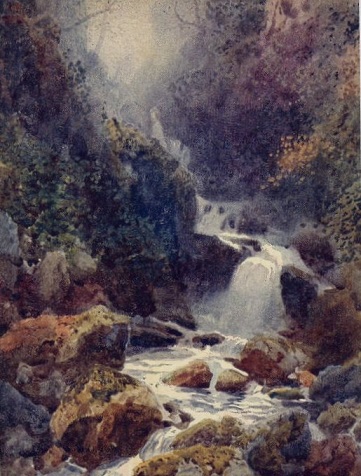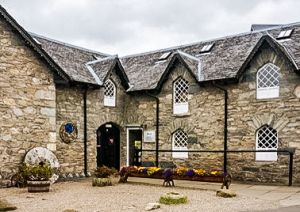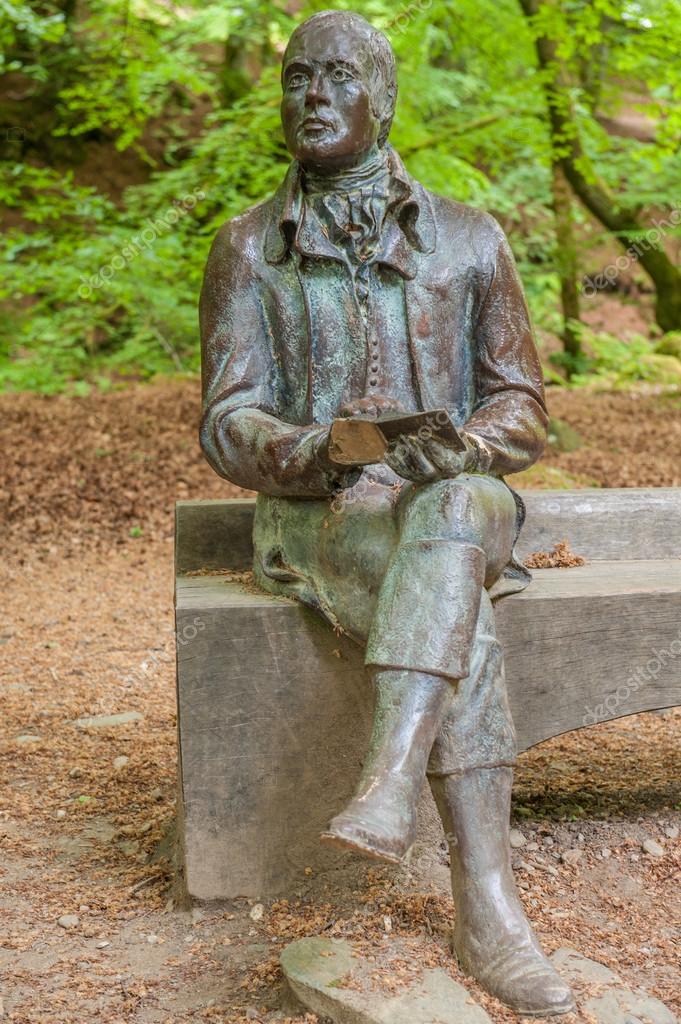[traduzione italiana]
“Birks of Aberfeldy” è stata scritta da Robert Burns nel 1787 adattandola ad una vecchia aria scozzese da danza dal titolo simile “The Birks Of Abergeldie”
[English translation]
The song “Birks of Aberfeldy” was written by Robert Burns in 1787 adapting it to an old Scottish dance tune called “The Birks Of Abergeldie”
The Den of Moness
Le Betulle di Aberfeldy sono un’amena e rinomata località del Loch Tay nel Perthshire, visitata da Robert Burns durante il suo tour per la Scozia con l’amico William Nicol.
La località a quei tempi era conosciuta come “The Den of Moness” essendo den una vecchia parola per indicare la tana o il rifugio, ma anche la grotta o gola e il Moness un fiume, che in quel punto ha scavato una spettacolare cascata tra le rocce.
Rabbie è rimasto così colpito dal torrente e dalle sue cascate, da descriverlo nella poesia!
La passeggiata di allora è ripercorribile anche oggi ed è un sentiero ad anello di circa 4 km denominato guarda caso “Birks di Aberfeldy”, lungo la gola del fiume con tre attraversamenti mediante ponticelli per passare da una sponda all’altra e ammirare le cascate (vedi).
Il paesaggio è molto suggestivo e in rete si trovano numerose descrizioni e fotografie riprese un po’ in tutte le stagioni e dalle più varie angolazioni.

Upper Falls of Moness

The Birks of Aberfeldy (Birches of Aberfeldy) is a pleasant and renowned locality of Loch Tay in Perthshire, visited by Robert Burns during his tour to Scotland with his friend William Nicol. The location at that time was known as “The Den of Moness” being “den” an old scottish word to indicate the den or shelter, but also the cave or gorge and the Moness a river that in that point has carved a spectacular waterfall between the rocks.
Rabbie was so struck by the stream and its waterfalls, to describe it in his poetry!
The walk of that time can be traced again today and it is a loop path of about 4 km called “Birks of Aberfeldy”, along the river gorge with three crossings by bridges to pass from one bank to the other and admire the waterfalls (see). The landscape is very suggestive and on the net there are numerous descriptions and photographs taken a little in all seasons and from the most various angles.


Il Mulino del Mugnaio e il Den of Moness
Un vecchio mulino era una volta la proprietà di un mugnaio benestante. Una notte il mulino prese fuoco e si bruciò completamente. Il mugnaio era disperato per la perdita del suo mulino. All’epoca le polizze assicurative non esistevano ancora, ma non era troppo tardi per le fate, e la buona fata di “Den of Moness” in quel momento si chiamava Pheallaiedh. Il mugnaio non ebbe alcuna esitazione, come invece pochissimi farebbero oggigiorno, nel cercare l’aiuto della Fata per la sua forte perdita.
Il mugnaio vagava per la Gola con il cuore a pezzi, in una sera d’estate qualche tempo dopo l’incendio del mulino, quando incontrò Pheallaidh, che gli disse: “Mugnaio, io ho ben compreso ciò che cerchi nei tuoi vagabondaggi. Vorresti ripristinare la tua perdita, e che la tua vita ritornasse a essere felice e prospera. Ciò ho intenzione di fare per colui che mi ha cercata con tutto il cuore. Ti do la scelta di due modi per riavere la tua felicità. Scegli quale prenderai: ricostruirò il tuo mulino e lo riempirò di nuovo con abbondante grano, e ci abiterai per ritornare un uomo prospero, oppure lascerò il tuo mulino nella sua attuale rovina e innalzerò dalle sue ceneri un luogo di bellezza che tutti potranno godere -un torrente incantevole, bellissimi alberi, uccelli canterini, l’alta felce e dolci fiori di campo; ricchi di quella pace di cui tutti gli uomini hanno bisogno e che porta con sé una benedizione sopra ogni cosa: un rifugio di bellezza e gioia. Scegli quale vuoi mugnaio.”
Era una scelta difficile da fare. Ci si aspettava che il mugnaio desiderasse avere di nuovo il suo mulino e la sua prosperità. Ma aveva acquisito saggezza nelle sue avversità e i suoi solitari vagabondaggi gli avevano insegnato molto sulle vere gioie della vita e su ciò che la natura può e fa per rendere felice l’uomo. Quindi, per quanto meraviglioso possa sembrare, il mugnaio scelse il luogo di bellezza della buona fata e Pheallaidh costruì per noi il delizioso rifugio che noi tutti chiamiamo “Birks di Aberfeldy”, e nei vecchi tempi “Ebair Pheallaidh”, il buon lavoro della Fata.
The miller’s mill and the Den of Moness
This old mill was once in the possession of a prosperous miller. One night the mill caught fire and was burnt out. The miller was in great distress over the loss of his mill. The time in which the miller lived was too soon for insurance policies, but it was not too late for fairies, and the good fairy of the Den of Moness at this time was called Pheallaiedh. The miller had no hesitation, as, indeed, very few would in those days, in seeking the help of the fairy of the fairy of the Den in his heavy loss.
The miller was wandering about the Den broken-hearted one summer’s evening some time after the mill fire when he met Pheallaidh, who said to him: “Miller, I wit well what thou are about in thy wanderings. Thou would’st have thy loss retrieved, and thy life made happy and prosperous again. This I am willing to do for one who has sought me so single-heartedly. I give you the choice of two ways of getting your happiness back. Choose which ye will take. Either I will rebuild thy mill and fill it again with rich grain, and get thee in it, and thou shalt once more be the prosperous man, or I will leave thy mill in its present ruin and raise from its ashes a beauty spot which all can enjoy-a lovely stream, beautiful trees, singing birds, the tall fern and sweet wildflowers; rich in that peace which all men needeth, and which carries with it a blessing above all things: a den of beauty and joy. Choose which thou wilt have miller.”
This was a difficult choice to make. The miller might well have been expected to wish to have again his mill and prosperity. But he had gained wisdom in his adversity, and his lonely wanderings had taught him much about the real joys of life and of what nature can and does give to make man happy. So, wonderful as it may seem, the miller chose the good fairy’s beauty spot, and Pheallaidh built up for us that lovely den which we all the Birks o’ Aberfeldy, and which was called in the old days Ebair Pheallaidh the good work of the fairy. (from Aberfeldy Museum)

SCOTCH AYRE
La melodia compare per la prima volta nel Dancing Master di J. Playford con il titolo di “Scotch Ayre (A)” e anche in varie raccolte da danza settecentesche.
La ritroviamo successivamente in varie pubblicazioni sotto i più svariati titoli: in Favourite Country Dances, vol. 2 (1765) di Charles & Samuel Thompson come ” The De’els Dead” e nella Compleat Collection of Celebrated Country Dances (1740) di Wright sia come “Berks of Abergelde” che “Cast a Bell” infine nel Scots Musical Museum, vol. 2 (1788) come “Bonnie Lassie Will You Go”.
La versione di Robert Burns
Robert Burns scrive alcune strofe ispirato dalle cascate di Moness durante il suo tour delle Highland nel 1787 con l’amico William Nicol. Mantenne il coro di una canzone più antica, il dialogo di un amante, intitolato “Birks of Albergedie”, stampato da David Herd (1776) e altri. La versione di Burns è stata stampata a Edimburgo nello Scots Musical Museum di James Johnson (volume 2, 1788, n. 113).
Così inizia la canzone tradizionale:
Bella ragazza vuoi venire vuoi venire, dai vieni?
Bella ragazza vuoi venire alle Betulle di Abergeldie?
Avrai un abito di seta, un abito di seta,
avrai un abito di seta, e una sopravveste di calamanco(1)
(1) tessuto di lana lucido quadrettato o broccato su di un lato
Davidona Pittock
The melody appears for the first time in J. Playford’s Dancing Master with the title of “Scotch Ayre (A)” and also in various eighteenth-century dance collections. We find it later in various publications under the most varied titles: in Favorite Country Dances , vol. 2 (1765) by Charles & Samuel Thompson as “The De’els Dead” and in Wright’s Compleat Collection of Celebrated Country Dances (1740) both as “Berks of Abergelde” and “Cast a Bell” finally in the Scots Musical Museum, vol . 2 (1788) as “Bonnie Lassie Will You Go”.
Instrumental arrangement from Robert Louis Stevenson‘s manuscript (Huntington Library)- for score
Robert Burns Version
Robert Burns writes some verses inspired by the Moness waterfalls during his Highland tour in 1787 with his friend William Nicol. He kept the chorus of an older song, a lover’s dialogue, entitled “Birks of Albergedie”, printed by David Herd (1776) and others. Burns version was printed in Edinburgh in James Johnson’s Scots Musical Museum (volume 2, 1788, No. 113).
The traditional song begins:
Bonny lassie, will ye go to the Birks o’ Abergeldie?
Ye shall get a gown of silk, a gown of silk, a gown of silk,
Ye shall get a gown of silk, and coat of calimancoe(1).
(1) petticoat of calamanco (see)

Chorus:
Bonnie lassie, will ye go,
Will ye go, will ye go?
Bonnie lassie, will ye go
Tae the birks of Aberfeldy?
I
Now Simmer blinks on flow’ry braes,
And o’er the crystal stream lets plays;
Come, let us spend the lightsome days
In the birks of Aberfeldy.
II
The little birdies blythely sing,
While o’er their heads the hazels hing,
Or lightly flit on wanton wing
In the birks of Aberfeldy.
III
The braes ascend like lofty wa’s,
The foaming stream, deep-roaring, fa’s
O’erhung wi’ fragrant-spreading shaws
The birks of Aberfeldy.
IV
The hoary cliffs are crown’d wi flowers,
White o’er the linns the burnie pours,
And, rising, weets wi’ misty showers
The birks of Aberfeldy.
V
Let Fortune’s gifts at random flee,
They ne’er shall draw a wish frae me;
Supremely blest wi’ love and thee
In the birks of Aberfeldy
Traduzione italiana di Cattia Salto
Ritornello
Bella ragazza vuoi venire
vuoi venire, dai vieni?
Bella ragazza vuoi venire
alle Betulle di Aberfeldy?
I
Ora l’estate risplende sui pendii fioriti
e gioca con il ruscello di cristallo;
vieni passiamo i giorni in allegria
alle Betulle di Aberfeldy
II
Gli uccellini spensierati cantano,
mentre sopra le loro teste pendono i noccioli,
o con leggerezza volteggiano sull’ala ribelle,
alle Betulle di Aberfeldy
III
Le rive salgono come alte mura,
il torrente spumeggiante, in un boato, cade,
sovrastato dai boschi che spandono le fragranze
delle Betulle di Aberfeldy
IV
Le balze nude sono coronate di fiori,
bianco nella cascata il torrente si riversa,
e, salendo, bagna con gocce di nebbia
le Betulle di Aberfeldy
V
I doni del Fato a caso cadono,
non hanno mai esaudito un mio desiderio,
(così sarò) sommamente benedetto dal tuo amore,
nelle betulle di Aberfeldy
Il gruppo russo di musica neo-folk di Anton Brejestovski reinterpreta il brano: il ritmo dell’arpa evoca le cascatelle del torrente e l’uso di più voci in canone nel ritornello è assolutamente da malia incantata-richiamo per catturare le belle fanciulle e coinvolgerle nella danza delle fate.
Il ripetuto invito ad andare nel bosco di Betulle sembra essere l’invito a entrare nel Mondo delle Fate
LINK
http://www.burnsscotland.com/items/v/volume-ii,-song-113,-pages-115-and-116-the-birks-of-aberfeldy.aspx
https://burnsc21.glasgow.ac.uk/the-birks-of-aberfeldy/
http://wikilivres.ca/wiki/Songs_of_Robert_Burns/Now_simmer_blinks_on_flowry_braes
http://www.robertburnsfederation.com/poems/translations/456.htm
http://www.fourjandals.com/europe/walking-the-birks-of-aberfeldy-the-falls-of-moness-exploring-scotland/
http://www.walkhighlands.co.uk/perthshire/birks-of-aberfeldy.shtml
http://www.robroyway.com/birks.html
https://sites.google.com/a/music-of-robert-louis-stevenson.org/birks-of-aberfeldy/
http://tunearch.org/wiki/Birks_of_Abergeldie_(The)
https://www.scottish-country-dancing-dictionary.com/birks-of-abergeldie.html
